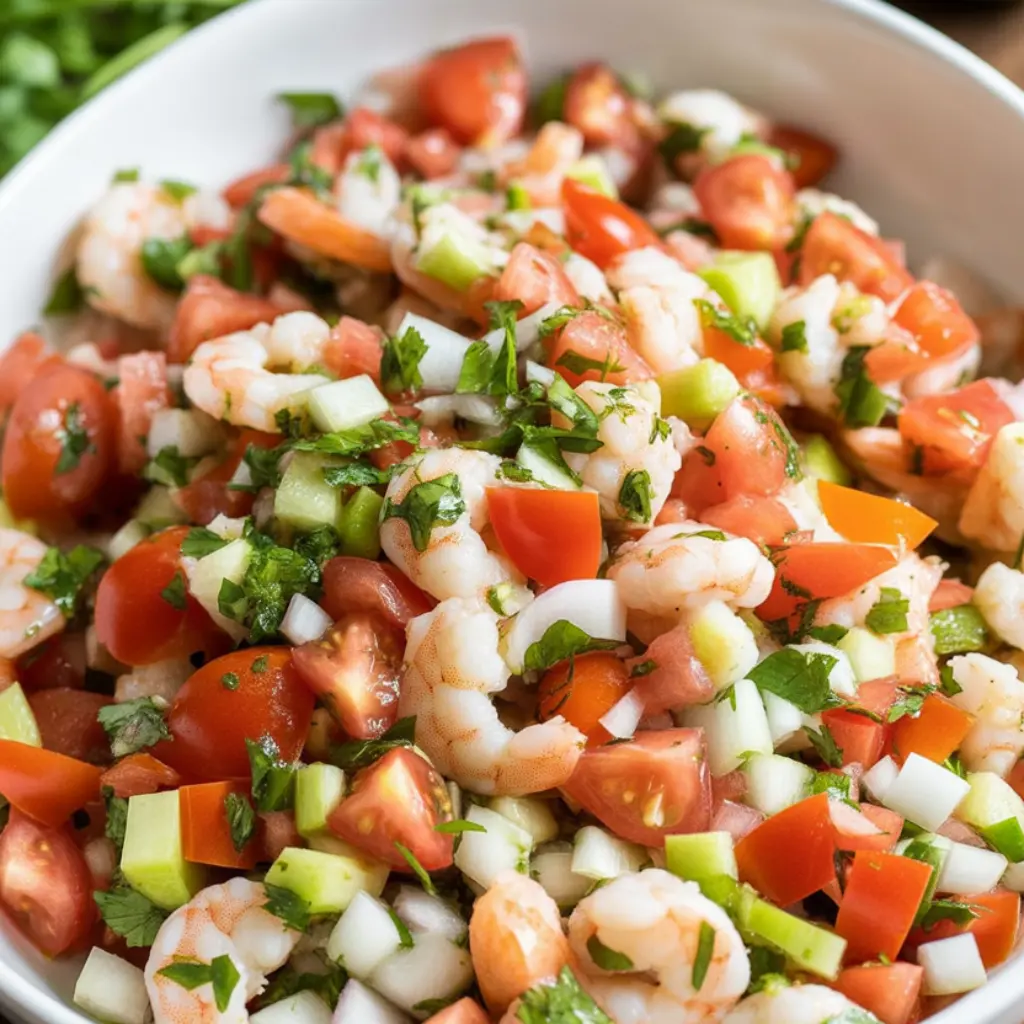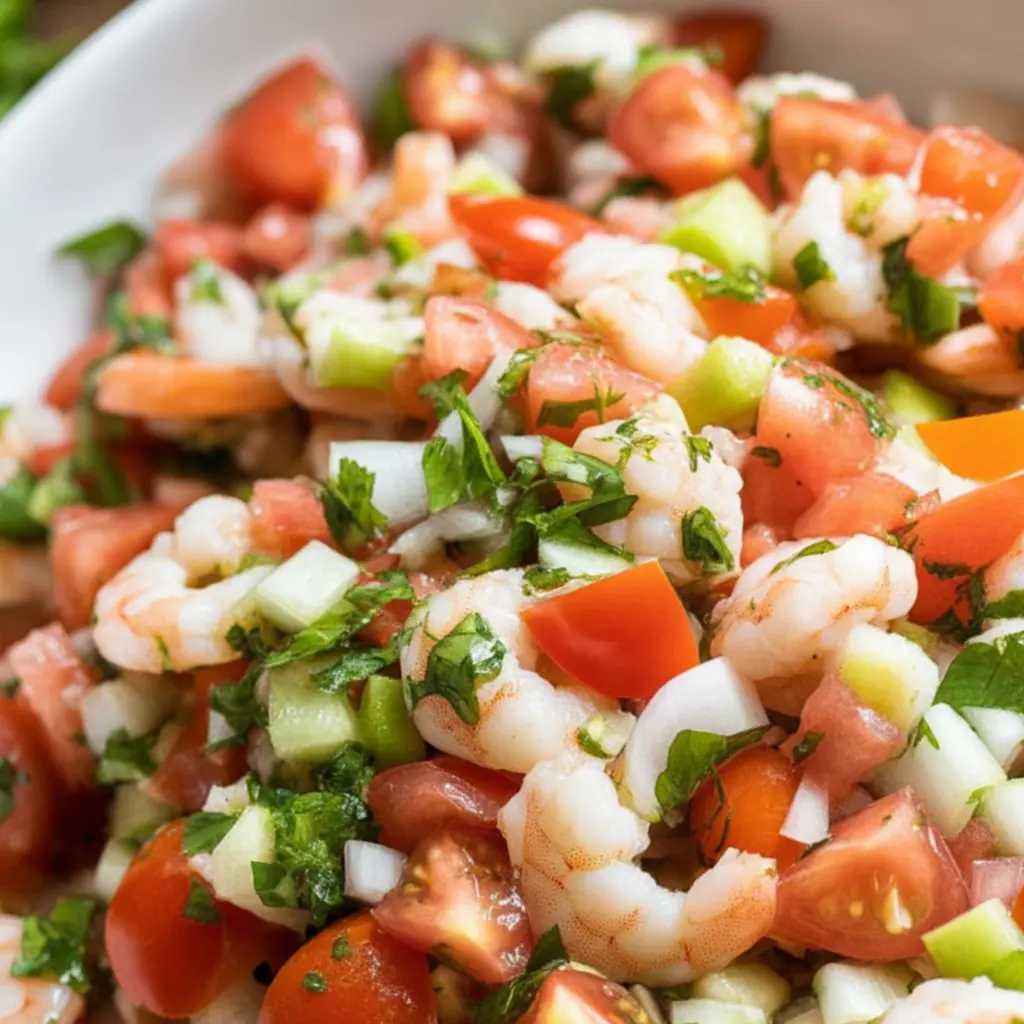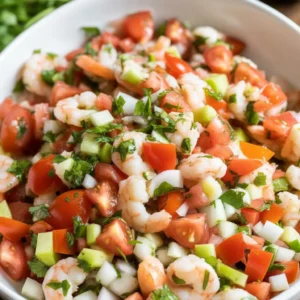There’s a certain kind of summer heat that doesn’t ask permission—it just shows up and plants itself in your kitchen, daring you to turn on the stove. That was the kind of day I had the first time I made shrimp ceviche.
I remember it vividly: I’d come home from the farmer’s market with a tote full of limes and a bunch of cilantro so fresh it still had garden dirt clinging to the roots. I was craving something light but full of flavor, something I could throw together without heating up the house or spending hours over the sink.
And there it was—shrimp ceviche—whispering like an old friend reminding me that sometimes the most refreshing meals are the ones that require the least.
That first batch wasn’t perfect. I rushed the lime soak, used too much onion, and didn’t give the shrimp enough time to chill. But I learned. And like most good recipes in my life, shrimp ceviche became less of a “dish” and more of a rhythm—something I could make by feel, adjusting the brightness and heat depending on the day. Over the years, it’s become my go-to for summer potlucks, lazy lunches, and even those solo nights when I just want something crisp, citrusy, and satisfying. I hope you’ll find the same comfort and joy in it.

Why You’ll Love This Recipe:
- No stove or oven required—perfect for hot days
- Comes together in under 30 minutes
- Light, fresh, and full of citrusy flavor
- Easy to customize with whatever you’ve got
- Perfect for entertaining or meal prepping ahead
Ingredients You’ll Need:
Shrimp (1 pound, peeled and deveined): I prefer using medium-sized raw shrimp, tail-off. You can use pre-cooked in a pinch, but you’ll miss out on that silky texture that comes from “cooking” in citrus. If you’re starting with frozen, just make sure they’re fully thawed and patted dry.
Fresh lime juice (about 1 cup, from 6–8 limes): This is the backbone of the ceviche. I’ve made the mistake of skimping here before and the flavor fell flat. Always use fresh—bottled lime juice just doesn’t carry the same zing.
Red onion (1 small, finely diced): It adds bite and color. I soak mine in cold water for 10 minutes before using to take the edge off.
Roma tomatoes (2, diced): Choose ripe but firm ones so they hold their shape. You can use cherry tomatoes halved if that’s what you have.
Cucumber (1/2 cup, peeled and diced): For crunch and a cooling contrast. I love using English cucumbers because they’re less watery.
Fresh cilantro (a big handful, chopped): This brings the garden-fresh lift. If you’re not a cilantro fan, flat-leaf parsley works okay, but the flavor will shift.
Jalapeño or serrano pepper (1, finely minced): For heat. I always taste mine before tossing it in—some peppers are sneakier than others.
Avocado (1, diced): Optional, but highly recommended for creaminess. I add it last so it doesn’t get mushy.
Salt and black pepper (to taste): Simple but essential. Taste before serving and adjust—lime juice dulls salt quickly.
How to Make It (Step-by-Step Instructions):
Start by chopping the shrimp into small bite-sized pieces. I like to cut each shrimp into thirds, so they soak evenly and are easy to scoop up with chips or forks. Place them in a glass or ceramic bowl—not metal, as the acidity can react and affect the flavor. Pour in enough lime juice to cover the shrimp fully, then give it a gentle stir. I cover the bowl and pop it in the fridge for about 20–25 minutes, or until the shrimp turns opaque and firms up. That’s how you know it’s “cooked.” Don’t leave it much longer than that—over-marinating can make them tough.
While the shrimp is soaking, I prep the vegetables. The onion goes into a small bowl with cold water and a pinch of salt. This trick I picked up from my mother-in-law—mellows the rawness and makes the flavor more balanced in the final dish. The rest—tomatoes, cucumber, pepper, and cilantro—I dice finely and toss together in a large mixing bowl.
Once the shrimp is ready, I drain off most of the lime juice, leaving just a few tablespoons for brightness. Then I fold the shrimp into the veggie mix. If I’m adding avocado, this is when I do it, carefully so it doesn’t break down. Season generously with salt and a few grinds of black pepper. Give it one last stir, then taste. Sometimes I’ll squeeze in an extra lime if the flavors need lifting, or toss in another pinch of cilantro if I want more herbal punch.
Now here’s the hardest part—letting it rest. I cover the bowl and refrigerate it for at least 15 more minutes. It’s tempting to dig in right away, but those few minutes allow everything to meld. And trust me, it’s worth the wait.

Expert Tips for the Best Results:
Ceviche is all about balance, and over the years I’ve learned that the key is to taste as you go and respect the timing. Don’t rush the citrus cure, but don’t let it sit for hours either—shrimp can get rubbery fast. Always chop your ingredients evenly for a better texture in every bite, and don’t skip chilling it before serving. It’s during that rest that the flavors come alive. I also keep a backup lime or two on hand—what tastes bright and zesty at first can mellow in the fridge, and a little fresh juice just before serving brings it all back to life.
Variations & Substitutions:
This dish is wonderfully forgiving. I’ve made it with chopped scallops when shrimp was out of budget, and it worked beautifully. On quieter grocery weeks, I’ve stretched the ceviche with extra cucumber and skipped the avocado. Once, I was out of tomatoes and added diced mango instead—it turned out so fresh and summery that now I do it on purpose when the fruit is ripe. If heat isn’t your thing, leave out the jalapeño or replace it with a small amount of sweet bell pepper for crunch without the fire. The key is tasting, trusting your gut, and using what you have.
Serving Suggestions:
I love serving this in a big, chilled glass bowl alongside a pile of sturdy tortilla chips—nothing too thin, or they’ll break. For something a bit more elegant, I spoon it into little glasses or halved avocados for a pretty starter. It’s perfect for warm evenings on the porch, beach picnics, or last-minute get-togethers when you don’t want to be stuck in the kitchen. Sometimes I even make it for lunch with saltine crackers and a sparkling water, just for me.
Storage & Reheating Instructions:
Ceviche doesn’t love to be stored for too long, but I’ve found it holds up well for about 24 hours in the fridge if covered tightly. After that, the texture starts to change and the shrimp can go a bit chewy. I don’t recommend freezing it or trying to reheat—it’s meant to be cold and crisp. If leftovers lose some of their brightness, a quick splash of fresh lime juice and a sprinkle of salt can perk them right up.
Recipe FAQs (Answered by Clara):
Can I make this ahead of time?
You sure can. I often prep the shrimp and veggies in the morning, keep them separate, and mix everything together an hour or so before serving. That way it’s fresh but fuss-free.
Is it safe to eat raw shrimp like this?
The lime juice “cooks” the shrimp by denaturing the proteins, which gives it that opaque, firm texture. But if you’re ever unsure or serving it to someone with a sensitive stomach, you can blanch the shrimp for one minute in boiling water and then chill before marinating.
What if I don’t like cilantro?
You’re not alone—some folks taste soap. Flat-leaf parsley makes a good substitute, or you can leave it out entirely and rely on lime and onion for brightness.
Can I use bottled lime juice?
Technically yes, but the flavor won’t be the same. I’ve done it in a pinch and it works, but I always come back to fresh limes for the best taste.
How spicy is this?
It really depends on the pepper you use and how much you add. Start small, taste as you go, and remember—it’s easier to add heat than to take it away.

Shrimp ceviche is one of those rare dishes that feels fancy but is actually so simple—no stovetop, no stress, just fresh ingredients and a little bit of patience. It’s a reminder, at least for me, that great cooking doesn’t always come from complexity—it often comes from care. I hope you’ll give this one a try, and if you do, I’d love to hear how it turned out. Did you add mango? Skip the pepper? Serve it on your porch with a cold drink? Let me know in the comments or just carry the recipe forward in your own way. From my kitchen to yours—enjoy every bright, zesty bite.
Nutrition Information (Per Serving – Approximate):
Calories: 180
Protein: 20g
Carbohydrates: 10g
Fat: 6g
Fiber: 3g
Sugar: 2g
Sodium: 320mg

Shrimp Ceviche
Ingredients
- 1 lb shrimp peeled and deveined (use small shrimp or chop large shrimp)
- ¾ cup freshly squeezed lime juice about 5–6 limes
- ¼ cup freshly squeezed lemon juice optional for flavor balance
- 1 medium red onion finely diced
- 1 medium tomato diced
- 1 jalapeño or serrano pepper minced (seeds removed for less heat)
- 1 cucumber peeled and diced
- ¼ cup chopped cilantro
- Salt and pepper to taste
- Optional: avocado diced; tortilla chips for serving
Instructions
- Prepare the shrimp: If using raw shrimp, bring a pot of water to a boil and parboil shrimp for 1–2 minutes until just opaque. Drain and chop into bite-sized pieces. If using pre-cooked shrimp, just chop and proceed.
- Marinate in citrus: Place shrimp in a glass or stainless-steel bowl. Add lime and lemon juice, making sure shrimp is fully submerged. Cover and refrigerate for 30–60 minutes until the shrimp turns opaque and firms up.
- Add vegetables and herbs: Stir in red onion, tomato, jalapeño, cucumber, and cilantro. Season with salt and pepper to taste.
- Chill and serve: Let the mixture chill for another 15–20 minutes to let flavors meld. Before serving, gently fold in diced avocado if using.
- Serve: Serve cold with tortilla chips, on tostadas, or in lettuce cups. Garnish with extra cilantro or lime wedges.
Notes
- Always use the freshest shrimp available—wild-caught is best.
- You can substitute lime juice with a mix of orange and lime for a milder, Peruvian-style ceviche.
- Add mango or pineapple for a tropical twist.
- Keep ceviche cold and consume within 24 hours for the best flavor and food safety.


Leave a Reply